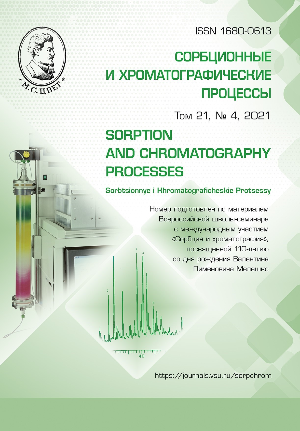Demineralization of heterocyclic amino acid solutions by an electromembrane method
Abstract
Electrodialysis with ion-exchange membranes is a promising method for the demineralization of amino acid solutions. The aim of this work is to establish the effect of the nature of mineral impurities on the efficiency of their extraction from solutions of a heterocyclic amino acid, proline (Pro), as well as on the losses of the product in the process of electromembrane desalination. Among the objectives of the research was to study proline mass transfer through heterogeneous ion-exchange membranes in the electrodialysis of its individual aqueous solution. It was shown that the flux of the heterocyclic amino acid from the individual solution through the MK-40 cation-exchange membrane was heavier than through the MA-41 anion-exchange membrane. The value of the diffusion-limited current was also higher for the MK-40 membrane, and the form of the dependence of the proline flux on the current density was conventional for the electrodialysis of ampholytes. The study of mixed solutions of an amino acid and a mineral salt revealed a competitive transport of mineral ions through ion-exchange membranes leading to a decrease in the mass transfer of Pro as compared with the individual solution. It was noted that the values of the fluxes of the given heterocyclic amino acid passing through the MA-41 membrane in the presence of various mineral ions at high current density increased in the sequence: Cl- < NO3- < SO42-. The following correlation was revealed for the studied systems: the higher ion mobility in the membrane phase corresponds to higher values of its fluxes. In addition, the fluxes of a heterocyclic amino acid through the MK-40 membrane increase in correlation with an increase in the hydration energy of the positively hydrated cation of an inorganic electrolyte. The estimeted demineralization parameters (the degree of desalination and amino acid losses) showed that among the studied solutions the process of demineralization conducted under the same experimental conditions was most evident in the proline + sodium nitrate system, and the smallest losses of the target product were recorded in the electrodialysis in the proline + ammonium chloride system. The effective separation of a heterocyclic amino acid and a mineral salt by the method of electrodialysis requires taking into account the influence of the nature of mineral salt ions, their hydration, and mobility in the phase of the ion-exchange membrane and in the solution.
Downloads
References
Aghajanyan A., Saribekyan Z., Saghyan A., Separation and Purification Technology, 2019, Vol. 55, pp. 771-778. DOI: 10.1080/01496395.2019.1574820
Yuan F., Wang Q., Yang P., Cong W., Separation and Purification Technology, 2016, Vol. 168, pp. 257-264.
Shaposhnik V.A., Eliseeva T.V., Journal of Membrane Science, 1999, Vol. 161, pp. 223-228.
Eliseeva T.V., Shaposhnik V.A., Russian Journal of Electrochemistry, 2000, Vol. 36, No 1, pp. 64-67.
Samoilov О.Y. Struktura vodnyh rastvorov elektrolitov i gidrataciya ionov, M., Publishing House of the Academy of Sciences of the USSR, 1957, 173 p.
Shaposhnik V.A., Kinetika elektrodializa, Voronezh, VSU, 1989, 176 p







